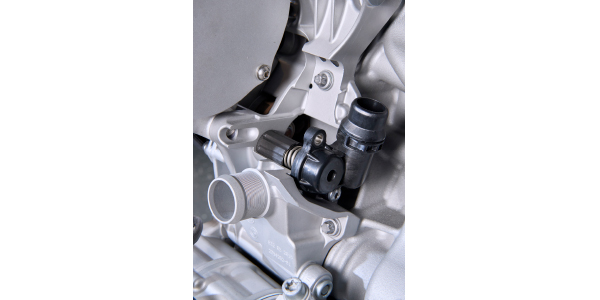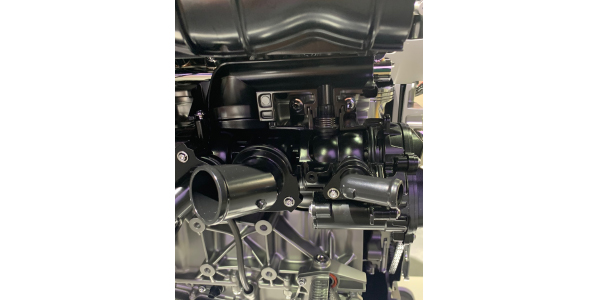Smart thermostats and pumps are adding a new wrinkle to diagnostics.
A conventional thermostat and water pump are similar to a carburetor and mechanical fuel pump in one regard – they can only respond to change, not be proactive in their engine management.
A carburetor and mechanical pump can only respond to throttle and engine speed and vacuum signals. Like the carburetor, a conventional thermostat and water pump can only react to changes in temperature.

With engines increasing performance in terms of compression ratio and combustion temperatures, cooling systems needed to enter into the fuel injection age. What is replacing the conventional water pump and thermostat are electronic thermostats and electric water pumps.
Thermostats
An electronic thermostat can preemptively control the temperature the same way the fuel injection system can control the stoichiometric ratio. By being able to control the temperature of the coolant, the engine management system can optimize engine performance for leaner combustion events.
These new electronic thermostats can also help prevent extreme heating conditions because they can be opened when certain conditions are detected. Factors like engine load, ambient temperature, engine RPM and ignition time can influence the position of the thermostat. These inputs can be configured into a “map” that can optimize engine performance. This means that the thermostat can have a completely different setting position when the vehicle is cruising along versus doing a wide-open-throttle launch.
Failure Mode
Most thermostats use wax inside a brass chamber that expands when it is heated. When it expands, it pushes on a pin or piston that is connected to the plate and spring. Movement of the plate allows coolant to flow from the bypass coolant circuit to the circuit that has the radiator. This system has been in operation since the 1950s.
For the wax to work and the thermostat to open, several things must happen. First, the brass chamber that contains the wax must be submerged in the coolant. Air does not transfer heat like coolant does. This requires that all the air is bled from the system. This is also why most thermostats have a “jiggle pin” that allows a small amount of coolant and air bubbles to pass so the wax is submerged. Second, for the engine to warm up uniformly, coolant must freely circulate past the wax pellet. To accomplish this, most engines have a coolant “bypass” between the water pump and intake manifold to allow coolant to circulate with the thermostat closed.

In some cases, manufacturers may use the vehicle’s heater hoses and heater core to circulate water through the engine block with the thermostat closed.
Some electrically controlled thermostats use a heater coil surrounding the wax capsule to control the temperature of the expanding wax, but some systems are using stepper motors or plungers to control coolant flow.
Overheating can damage the wax in the thermostat. This is why it is always a good practice to replace the thermostat on a vehicle after it has overheated. This is also true on electric thermostats because the overheating could damage the heating coils.
Most thermostats are designed to fail in the open position. This prevents catastrophic overheating but also means that the engine will have a more extended warm-up period, which could inadvertently damage the engine. In the case of the electronically controlled thermostat, the engine management system will recognize this failure and set a code due to the inability to change the coolant temperature.
Both types of thermostats can suffer mechanical damage that prevents them from closing and opening. This can include damage to the springs and straps on the body of the thermostat. Also, debris and corrosion can prevent a thermostat from working.
With electric valves and plungers, the components can fail over time and be damaged by worn out or contaminated coolant.
When the heater or driver circuit fails on an electronically controlled thermostat, the thermostat becomes a conventional thermostat and will not cause the engine to overheat. Electronic valves are designed to fail or reset into an open position. However, the engine will know it has failed and will set a code because actuation of the thermostat does not generate the expected result, or the module detects a problem with the circuit.
Identification
The majority of vehicles with an electronically controlled thermostat have a thermostat module, housing or unit. On the side of the thermostat housing, there will be a connector that you might assume is a temperature sensor. Like a coolant temperature sensor, it will have a two-wire connector – but it is usually a much more versatile component.
One wire will be a ground and the other will supply voltage to the heating coil. The voltage to the coil will be regulated by the engine management system. Some systems will turn the voltage on or off as needed. Some systems will use a pulse-width modulated signal to control the temperature like a heater on an oxygen sensor.
With the average electronically controlled thermostat module costing more than $130, it is critical to test the component and circuit before installing a new part.
The first component to check is the circuit. If the system has a code for an open or short in the circuit, clear the code. If the code comes back immediately, you have confirmed the problem, unless the problem is in the heater coil or the circuit on the vehicle. You can determine if the coil is bad by measuring the resistance in the component. If it is open, the heating coil is damaged. If it is not open, measure the resistance and check the specification in the service information.
You can also use an amp clamp to determine if the engine management system is sending voltage to the component. These systems can either be ground or positive voltage switched. You can also see the switching if you have a scan tool that can watch this data. Some scan tools can even bidirectionally control the heater circuit.
Electric Water Pumps
If a water pump is driven by a belt, it has several inherent disadvantages. First, the speed of the pump is controlled by the engine. When the engine is idling, the pump is turning slowly and not moving much coolant. If the engine is operating at higher speed, the pump is moving a greater volume of coolant. This can cause overcooling of the engine and if the pump spins too fast, the coolant can actually cavitate. An electric water pump can solve these problems and even improve cold-start emissions.
Electric water pumps are not new technology – many luxury vehicles and diesel vehicles have used auxiliary water pumps for years to control the flow of coolant through the heater core. The next generation of electric pumps controls the coolant flow in the block and head.
The control of the electric water pump depends on more than just temperature sensors. The speed of the pump also depends on how rich or lean the engine is running. With engines running leaner fuel mixtures, the temperature of the head and cylinder can rapidly increase and even develop hot spots that lead to detonation and pre-ignition. An electric pump can quickly cool the combustion chamber instead of waiting for a thermostat to open.
If a vehicle has greater control over the engine cooling system by using an intelligent thermostat and pump, it means that the cooling system needs less coolant and a smaller radiator. The advantages are reduced warm-up times and better aerodynamics. Some manufacturers have even taken the next step with active grille shutters, but that is a topic for another article.
Article courtesy Underhood Service.













